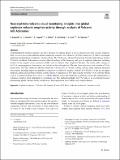Files in this item
Near-real-time volcanic cloud monitoring : insights into global explosive volcanic eruptive activity through analysis of Volcanic Ash Advisories
Item metadata
| dc.contributor.author | Engwell, S. | |
| dc.contributor.author | Mastin, L. | |
| dc.contributor.author | Tupper, A. | |
| dc.contributor.author | Kibler, J. | |
| dc.contributor.author | Acethorp, P. | |
| dc.contributor.author | Lord, G. | |
| dc.contributor.author | Filgueira, R. | |
| dc.date.accessioned | 2022-02-10T13:30:10Z | |
| dc.date.available | 2022-02-10T13:30:10Z | |
| dc.date.issued | 2021-02 | |
| dc.identifier | 277807022 | |
| dc.identifier | 1433e6a5-eb52-4c41-bf78-e49ca8189287 | |
| dc.identifier | 85099984841 | |
| dc.identifier.citation | Engwell , S , Mastin , L , Tupper , A , Kibler , J , Acethorp , P , Lord , G & Filgueira , R 2021 , ' Near-real-time volcanic cloud monitoring : insights into global explosive volcanic eruptive activity through analysis of Volcanic Ash Advisories ' , Bulletin of Volcanology , vol. 83 , no. 2 , 9 . https://doi.org/10.1007/s00445-020-01419-y | en |
| dc.identifier.issn | 0258-8900 | |
| dc.identifier.other | Bibtex: b506c908d6964f60ada4ea10c65d6fca | |
| dc.identifier.uri | https://hdl.handle.net/10023/24844 | |
| dc.description | SLE was funded by the Global Geological Risk Research Platform of the British Geological Survey NC-ODA grant NE/R000069/1: Geoscience for Sustainable Futures. | en |
| dc.description.abstract | Understanding the location, intensity, and likely duration of volcanic hazards is key to reducing risk from volcanic eruptions. Here, we use a novel near-real-time dataset comprising Volcanic Ash Advisories (VAAs) issued over 10 years to investigate global rates and durations of explosive volcanic activity. The VAAs were collected from the nine Volcanic Ash Advisory Centres (VAACs) worldwide. Information extracted allowed analysis of the frequency and type of explosive behaviour, including analysis of key eruption source parameters (ESPs) such as volcanic cloud height and duration. The results reflect changes in the VAA reporting process, data sources, and volcanic activity through time. The data show an increase in the number of VAAs issued since 2015 that cannot be directly correlated to an increase in volcanic activity. Instead, many represent increased observations, including improved capability to detect low- to mid-level volcanic clouds (FL101–FL200, 3–6 km asl), by higher temporal, spatial, and spectral resolution satellite sensors. Comparison of ESP data extracted from the VAAs with the Mastin et al. (J Volcanol Geotherm Res 186:10–21, 2009a) database shows that traditional assumptions used in the classification of volcanoes could be much simplified for operational use. The analysis highlights the VAA data as an exceptional resource documenting global volcanic activity on timescales that complement more widely used eruption datasets. | |
| dc.format.extent | 17 | |
| dc.format.extent | 3774685 | |
| dc.language.iso | eng | |
| dc.relation.ispartof | Bulletin of Volcanology | en |
| dc.subject | Explosive eruptions | en |
| dc.subject | Volcanic Ash Advisory Centres (VAACs) | en |
| dc.subject | Volcanic ash hazard | en |
| dc.subject | Volcanic record | en |
| dc.subject | GB Physical geography | en |
| dc.subject | GE Environmental Sciences | en |
| dc.subject | QA75 Electronic computers. Computer science | en |
| dc.subject | QE Geology | en |
| dc.subject | 3rd-DAS | en |
| dc.subject.lcc | GB | en |
| dc.subject.lcc | GE | en |
| dc.subject.lcc | QA75 | en |
| dc.subject.lcc | QE | en |
| dc.title | Near-real-time volcanic cloud monitoring : insights into global explosive volcanic eruptive activity through analysis of Volcanic Ash Advisories | en |
| dc.type | Journal article | en |
| dc.contributor.institution | University of St Andrews. School of Computer Science | en |
| dc.identifier.doi | 10.1007/s00445-020-01419-y | |
| dc.description.status | Peer reviewed | en |
This item appears in the following Collection(s)
Items in the St Andrews Research Repository are protected by copyright, with all rights reserved, unless otherwise indicated.

